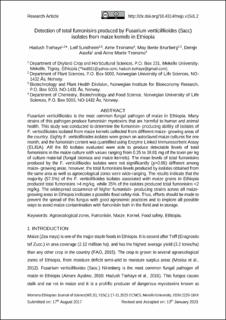| dc.contributor.author | Beyene, Hadush Tsehaye | |
| dc.contributor.author | Sundheim, Leif | |
| dc.contributor.author | Tronsmo, Arne | |
| dc.contributor.author | Brurberg, May Bente | |
| dc.contributor.author | Assefa, Dereje | |
| dc.contributor.author | Tronsmo, Anne Marte | |
| dc.date.accessioned | 2023-12-20T14:41:43Z | |
| dc.date.available | 2023-12-20T14:41:43Z | |
| dc.date.created | 2023-11-06T20:31:55Z | |
| dc.date.issued | 2023-05-21 | |
| dc.identifier.citation | Momona Ethiopian Journal of Science (MEJS). 2023, 15 (1), 17-31. | en_US |
| dc.identifier.issn | 2073-073X | |
| dc.identifier.uri | https://hdl.handle.net/11250/3108454 | |
| dc.description.abstract | Fusarium verticillioides is the most common fungal pathogen of maize in Ethiopia. Many strains of this pathogen produce fumonisin myotoxins that are harmful to human and animal health. This study was conducted to determine the fumonisin-producing ability of isolates of F. verticillioides isolated from maize kernels collected from different maize- growing areas of the country. Eighty F. verticillioides isolates were grown on autoclaved maize cultures for one month, and the fumonisin content was quantified using Enzyme Linked Immunosorbent Assay (ELISA). All the 80 isolates evaluated were able to produce detectable levels of total fumonisins in the maize culture with values ranging from 0.25 to 38.01 mg of the toxin per kg of culture material (fungal biomass and maize kernels). The mean levels of total fumonisins produced by the F. verticillioides isolates were not significantly (p>0.05) different among maize growing areas, however, the total fumonisins levels produced by isolates obtained from the same area as well as agroecological zones were wide-ranging. The results indicate that the majority (57.5%) of the F. verticillioides isolates associated with maize grains in Ethiopia produced total fumonisins >4 mg/kg, while 35% of the isolates produced total fumonisins <2 mg/kg. The widespread occurrence of higher fumonisin-producing strains across all maize-growing areas in Ethiopia indicates a possible food safety risk. Thus, efforts should be made to prevent the spread of this fungus with good agronomic practices and to implore all possible ways to avoid maize contamination with fumonisin both in the field and in storage. | en_US |
| dc.language.iso | eng | en_US |
| dc.publisher | African Journals Online | en_US |
| dc.rights | Navngivelse 4.0 Internasjonal | * |
| dc.rights.uri | http://creativecommons.org/licenses/by/4.0/deed.no | * |
| dc.title | Detection of total fumonisins produced by Fusarium verticillioides (Sacc) isolates from maize kernels in Ethiopia | en_US |
| dc.title.alternative | Detection of total fumonisins produced by Fusarium verticillioides (Sacc) isolates from maize kernels in Ethiopia | en_US |
| dc.type | Peer reviewed | en_US |
| dc.type | Journal article | en_US |
| dc.description.version | publishedVersion | en_US |
| dc.rights.holder | © CNCS, Mekelle University, | en_US |
| dc.source.pagenumber | 17-31 | en_US |
| dc.source.volume | 15 | en_US |
| dc.source.journal | Momona Ethiopian Journal of Science (MEJS) | en_US |
| dc.source.issue | 1 | en_US |
| dc.identifier.doi | 10.4314/mejs.v15i1.2 | |
| dc.identifier.cristin | 2192945 | |
| cristin.ispublished | true | |
| cristin.fulltext | original | |
| cristin.qualitycode | 1 | |

